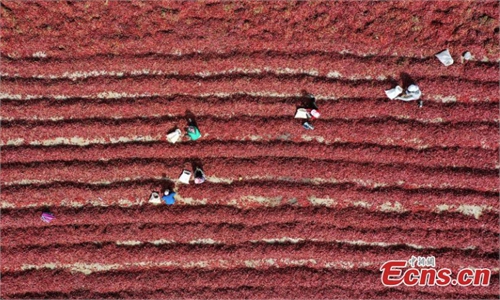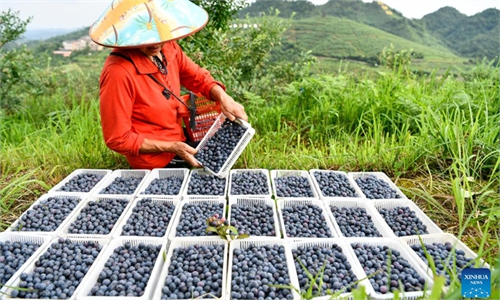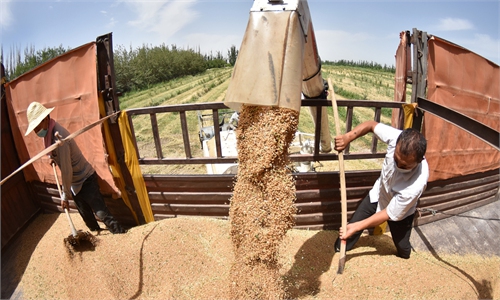After a decade of achievements, China to further enhance food security, rural devt: official

Aerial photo taken on June 12, 2022 shows a harvester working in the field in Dongjiazhuang Village of Difang Township in Pingyi County, Linyi City, east China's Shandong Province. By 5 pm this Monday, Shandong Province, China's second-largest wheat-producing area, had finished reaping winter wheat on 40.223 million mu (about 2.68 million hectares) of farmland, accounting for around 67 percent of its total winter wheat.(Photo: Xinhua)
After a decade of solid efforts to ensure food security, China will further expand food production capacity to stabilize domestic food production and supply, in a bid to cope with the uncertainty brought by the external environment and firmly hold the initiative of national food security, an official from the Ministry of Agriculture and Rural Affairs (MOA) said on Monday.
Ensuring food security for 1.4 billion people is always the top priority in the governance of China, Deng Xiaogang, vice minister of the MOA, said at a press conference on Monday, where he highlighted the country's achievements in the agricultural and rural sectors over the past decade since the 18th National Congress of the Communist Party of China in 2012.
"During the past 10 years, China has cultivated and promoted a number of high-yielding, high-quality, multi-resistant and widely adapted seeds, with the farmland area of independently developed crops accounting for more than 95 percent," Deng said.
Deng said that China has around 900 million mu (60 million hectares) of high-standard farmland, with improved supporting irrigation water facilities.
China's grain production capacity has steadily increased, with output stabilizing at more than 1.3 trillion jin (650 million tons) for seven consecutive years, reaching a record high of 1.3657 trillion jin in 2021, with per capita grain resources reaching 483 kilograms, achieving basic grain self-sufficiency and food security.
The country has always promoted mechanization in the agriculture sector to improve grain production and harvest efficiency, as well as reduce production costs, the official noted. The mechanization rate of plowing and harvesting of China's three major food crops - what, corn and rice - exceeded 97 percent, 90 percent and 85 percent, respectively.
"With the efforts of the central and local governments, this year's summer wheat harvest has become a certainty, laying a solid foundation for the annual grain yield and harvest," Deng noted.
Amid escalating international tensions, which could engulf the world in a potential food crisis, China has moved to ensure food security and is requiring local authorities to do all they can to guarantee the summer wheat harvest and expand the planting of soybeans. China relies heavily on imports of soybeans.
So far, the country has seen effective achievements in soybean production. The planting area of rapeseed - a major raw material for oil production - increased significantly and is expected to exceed 100 million mu in 2022.
Global Times



